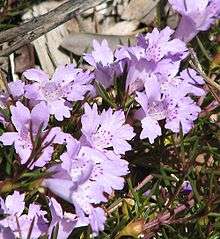Hemiandra
| Hemiandra | |
|---|---|
 | |
| Hemiandra pungens | |
| Scientific classification | |
| Kingdom: | Plantae |
| (unranked): | Angiosperms |
| (unranked): | Eudicots |
| (unranked): | Asterids |
| Order: | Lamiales |
| Family: | Lamiaceae |
| Genus: | Hemiandra R. Br. |
Hemiandra, commonly known as snakebush, is a genus of plants of the family Lamiaceae, first described in 1810. The genus is endemic to Australia (Queensland and Western Australia).[1] They are all prostrate to smallish shrubs allied to Westringia. The red, lilac, pink, or white flowers are 2-lipped, the lower lip enlarged and spotted. The stiff, narrow leaves often have prickly tips.
- Species
- Hemiandra australis B.J.Conn ined.
- Hemiandra bellairsiana B.J.Conn ined.
- Hemiandra coccinea O.H.Sarg. - Western Australia
- Hemiandra gardneri O.H.Sarg., Red Snakebush - Western Australia
- Hemiandra glabra Benth. = Hemiandra pungens R.Br
- Hemiandra hancocksiana B.J.Conn ined.
- Hemiandra incana Bartl. - Western Australia
- Hemiandra leiantha Benth. - Western Australia, Queensland
- Hemiandra linearis Benth., Speckled Snakebush = Hemiandra pungens R.Br
- Hemiandra pungens R.Br., Snakebush - Western Australia
- Hemiandra rubriflora O.H.Sarg. - Western Australia
- †Hemiandra rutilans O.H.Sarg. Colourful Snakebush - Western Australia but extinct
Cultivation
They need very well-drained, preferably sandy soil and prefer a sunny spot, although they will tolerate some shade. They prefer drier, temperate zones and need only be watered sparingly. Prune regularly to keep them tidy and to prolong flowering. Propagate from fresh seed or cuttings. They are prone to fungal diseases in humid conditions. Some success has been had by grafting them onto Westringia stock.
References
- "Hemiandra". FloraBase. Western Australian Government Department of Parks and Wildlife.